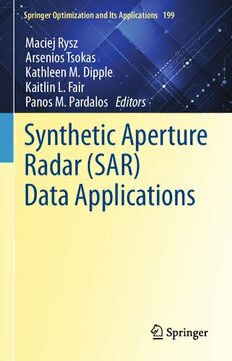Table Of ContentSpringer Optimization and Its Applications 199
Maciej Rysz
Arsenios Tsokas
Kathleen M. Dipple
Kaitlin L. Fair
Panos M. Pardalos Editors
Synthetic Aperture
Radar (SAR)
Data Applications
Springer Optimization and Its Applications
Volume 199
SeriesEditors
PanosM.Pardalos ,UniversityofFlorida
MyT.Thai ,UniversityofFlorida
HonoraryEditor
Ding-ZhuDu,UniversityofTexasatDallas
AdvisoryEditors
RomanV.Belavkin,MiddlesexUniversity
JohnR.Birge,UniversityofChicago
SergiyButenko,TexasA&MUniversity
VipinKumar,UniversityofMinnesota
AnnaNagurney,UniversityofMassachusettsAmherst
JunPei,HefeiUniversityofTechnology
OlegProkopyev,UniversityofPittsburgh
SteffenRebennack,KarlsruheInstituteofTechnology
MauricioResende,Amazon
TamásTerlaky,LehighUniversity
VanVu,YaleUniversity
MichaelN.Vrahatis,UniversityofPatras
GuoliangXue,ArizonaStateUniversity
YinyuYe,StanfordUniversity
AimsandScope
Optimizationhascontinuedtoexpandinalldirectionsatanastonishingrate.New
algorithmicandtheoreticaltechniquesarecontinuallydevelopingandthediffusion
into other disciplines is proceeding at a rapid pace, with a spot light on machine
learning, artificial intelligence, and quantum computing. Our knowledge of all
aspects of the field has grown even more profound. At the same time, one of the
most striking trends in optimization is the constantly increasing emphasis on the
interdisciplinary nature of the field. Optimization has been a basic tool in areas
not limited to applied mathematics, engineering, medicine, economics, computer
science,operationsresearch,andothersciences.
The series Springer Optimization and Its Applications (SOIA) aims to publish
state-of-the-art expository works (monographs, contributed volumes, textbooks,
handbooks)thatfocusontheory,methods,andapplicationsofoptimization.Topics
coveredinclude,butarenotlimitedto,nonlinearoptimization,combinatorialopti-
mization,continuousoptimization,stochasticoptimization,Bayesianoptimization,
optimalcontrol,discreteoptimization,multi-objectiveoptimization,andmore.New
totheseriesportfolioincludeWorksattheintersectionofoptimizationandmachine
learning,artificialintelligence,andquantumcomputing.
Volumes from this series are indexed by Web of Science, zbMATH, Mathematical
Reviews,andSCOPUS.
Maciej Rysz (cid:129) Arsenios Tsokas (cid:129)
Kathleen M. Dipple (cid:129) Kaitlin L. Fair (cid:129)
Panos M. Pardalos
Editors
Synthetic Aperture Radar
(SAR) Data Applications
Editors
MaciejRysz ArseniosTsokas
InformationSystems&Analytics Industrial&SystemsEngineering
MiamiUniversity UniversityofFlorida
Oxford,OH,USA Gainesville,FL,USA
KathleenM.Dipple KaitlinL.Fair
U.S.AirforceResearchLaboratory U.S.AirForceResearchLaboratory
(AFRL) (AFRL)
EglinAFB,FL,USA EglinAFB,FL,USA
PanosM.Pardalos
Industrial&SystemsEngineering
UniversityofFlorida
Gainesville,FL,USA
ISSN1931-6828 ISSN1931-6836 (electronic)
SpringerOptimizationandItsApplications
ISBN978-3-031-21224-6 ISBN978-3-031-21225-3 (eBook)
https://doi.org/10.1007/978-3-031-21225-3
MathematicsSubjectClassification:68Txx,68T07,62-XX,62R07
©TheEditor(s)(ifapplicable)andTheAuthor(s),underexclusivelicensetoSpringerNatureSwitzerland
AG2022
AllrightsaresolelyandexclusivelylicensedbythePublisher,whetherthewholeorpartofthematerialis
concerned,specificallytherightsoftranslation,reprinting,reuseofillustrations,recitation,broadcasting,
reproductiononmicrofilmsorinanyotherphysicalway,andtransmissionorinformationstorageand
retrieval,electronicadaptation,computersoftware,orbysimilarordissimilarmethodologynowknown
orhereafterdeveloped.
Theuseofgeneraldescriptivenames,registerednames,trademarks,servicemarks,etc.inthispublication
doesnotimply,evenintheabsenceofaspecificstatement,thatsuchnamesareexemptfromtherelevant
protectivelawsandregulationsandthereforefreeforgeneraluse.
Thepublisher,theauthors,andtheeditorsaresafetoassumethattheadviceandinformationinthisbook
arebelievedtobetrueandaccurateatthedateofpublication.Neitherthepublishernortheauthorsor
theeditorsgiveawarranty,expressedorimplied,withrespecttothematerialcontainedhereinorforany
errorsoromissionsthatmayhavebeenmade.Thepublisherremainsneutralwithregardtojurisdictional
claimsinpublishedmapsandinstitutionalaffiliations.
ThisSpringerimprintispublishedbytheregisteredcompanySpringerNatureSwitzerlandAG
Theregisteredcompanyaddressis:Gewerbestrasse11,6330Cham,Switzerland
Preface
SyntheticApertureRadar(SAR)DataApplicationspresentsadiversecollectionof
state-of-the-artapplicationsofSARdata.Itsaimistocreateachannelofcommuni-
cationofideasonongoingandevolvingusesandtoolsemployingmachinelearning,
and especially deep learning, methods in a series of SAR data applications. This
book comprises a variety of innovative ideas, original works, research results, and
reviewsfromeminentresearchers,spanningfromtargetdetectionandnavigationto
landclassificationandinterferencemitigation.
Syntheticapertureradar(SAR)isamicrowaveremotesensingtechnologywhich
was first conceived in the early 1950s. SAR technology has since seen rapid
progress. Today, SAR systems are operated from elevated places on land, from
mannedandunmannedaircraftandspacecraft.SARscanprovideimagesona24-h
basisandinallkindsofweatherandhavetheabilitytopenetrateclouds,fog,and,in
somecases,leaves,snow,andsand.Theygeneratemapsanddatadescribingfeatures
of the surface or reflective object. The advent of machine learning in the SAR
community created new opportunities and facilitated tasks in SAR data analysis.
Machinelearningtoolsofferaningenuitytoexistingandnewalgorithms.
Theeditorsofthisbookbroughttogetherdiversetopicswiththeaimtospotlight
interdisciplinary cutting-edge lines of research that can be useful to a wider
audience.SyntheticApertureRadar(SAR)DataApplicationsisaddressedtoexpert
practitioners and general public in industry and academia interested in modern
practicesandapplicationsusingSARdata.Individualsororganizationswithintent
or ongoing efforts that involve machine learning with SAR data are expected to
significantlybenefit.
Matthew P. Masarik, Chris Kreucher, Kirk Weeks, and Kyle Simpson in the
first chapter, “End-to-End ATR Leveraging Deep Learning,” discuss the need for
efficientandreliableautomatictargetrecognition(ATR)algorithmsthatcaningest
a SAR image, find all the objects of interest in the image, classify these objects,
and output properties of the objects. Their chapter lays out the required steps in
anyapproachforperformingthesefunctionsanddescribesasuiteofdeeplearning
algorithmswhichperformthisend-to-endSARATR.
v
vi Preface
Luca Bergamasco and Francesca Bovolo in their chapter “Change Detection in
SARImagesUsingDeepLearningMethods”focusonunsuperviseddeeplearning
changedetectionmethodsthatexploitunsuperviseddeeplearningmodelstoextract
feature maps. The feature maps retrieved from these models are used to detect
changed areas in multi-temporal images and handle the speckle noise. Change
detection methods address the regular monitoring of target areas by identifying
changesoverananalyzedareausingbi-temporalormulti-temporalSARimages.
Seonho Park, Maciej Rysz, Kathleen Dipple, and Panos Pardalos in their chap-
ter “Homography Augmented Momentum Contrastive Learning for SAR Image
Retrieval” propose a deep learning image retrieval approach using homography
transformation augmented contrastive learning to achieve scalable SAR image
searchtasks.Theyintroduceatrainingmethodforthedeepneuralnetworksinduced
by contrastive learning that does not require data labeling, which, in turn, enables
tractability of large-scale datasets with relative ease. The effectiveness of their
methodisdemonstratedonpolarimetricSARimagedatasets.
Alexander Semenov, Maciej Rysz, and Garrett Demeyer in their chapter “Syn-
thetic Aperture Radar Image Based Navigation Using Siamese Neural Networks”
propose Siamese network models with contrastive and triplet loss that can be
used for navigational tasks. They use the SqueezeNet deep neural network as
theirbackbonearchitectureduetoitscompactsizeincomparisontootherpopular
architecturesthatareoftenusedinSARimageprocessingtasks.Theirexperiments
demonstratethattheirmethodcanbeusedeffectivelyandholdsmuchpromisefor
futurenavigationaltasks.
JinXing,RuLuo,LifuChen,JielanWang,XingminCai,ShuoLi,PhilBlythe,
Yanghanzi Zhang, and Simon Edwards in their chapter “A Comparison of Deep
Neural Network Architectures in Aircraft Detection from SAR Imagery” compare
the performance of six popular deep neural networks for aircraft detection from
SAR imagery, to verify their performance in tackling the scale heterogeneity, the
background interference, and the speckle noise challenges in SAR-based aircraft
detection.Theirworkconfirmsthevalueofdeeplearninginaircraftandservesasa
baselineforfuturedeeplearningcomparisoninremotesensingdataanalytics.
Yan Huang, Lei Zhang, Jie Li, Mingliang Tao, Zhanye Chen, and Wei Hong
in their chapter “Machine Learning Methods for SAR Interference Mitigation”
provideacomprehensivestudyoftheinterferencemitigationtechniquesapplicable
for an SAR system. They provide typical signal models for various interference
types, together with many illustrative examples from real SAR data. In addition,
theyanalyzeadvancedsignalprocessingtechniques,specificallymachinelearning
methods, for suppressing interferences in detail. They discuss advantages and
drawbacks of each approach in terms of their applicability and future trends from
theperspectiveofcognitiveanddeeplearningframeworks.
MeteAhishali,SerkanKiranyaz,andMoncefGabboujintheirchapter“Classifi-
cationofSARImagesUsingCompactConvolutionalNeuralNetworks”investigate
the performance of compact convolutional neural networks that aim for minimum
computationalcomplexityandlimitedannotateddatafortheclassificationofSAR
images.TheiranalysiscoverscommonlyusedSARbenchmarkdatasetsconsisting
Preface vii
offourfullypolarimetric,onedual-,andonesingle-polarizedSARdataincluding
bothspaceborneandairbornesensors.
Siddharth Hariharan, Dipankar Mandal, Siddhesh Tirodkar, Vineet Kumar, and
AvikBhattacharyaintheirchapter“Multi-frequencyPolarimetricSARDataAnaly-
sisforCropTypeClassificationUsingRandomForest”employmulti-frequency(C-,
L-,andP-bands)single-dateAIRSARdatausingrandomforest–basedpolarimetric
parameterselectionforcropseparationandclassification.Intheirstudy,inaddition
topolarimetricbackscatteringcoefficients,theyalsoanalyzedscatteringdecompo-
sition powers along with the backscattering ratio parameters and found them vital
formulti-frequencycropclassification.
EmrullahAcarandMehmetSiracOzerdemintheirchapter“AutomaticDetermi-
nationofDifferentSoilTypesviaSeveralMachineLearningAlgorithmsEmploying
Radarsat-2SARImagePolarizationCoefficients”exploreseveralmachinelearning
algorithms—K-NearestNeighbor,ExtremeLearningMachine,andNaiveBayes—
by utilizing Radarsat-2 SAR data in a pilot region in the city of Diyarbakir,
Turkey. They collect 156 soil samples for classification of two soil types (Clayey
and Clayey+Loamy), compute four different Radarsat-2 SAR image polarization
coefficients for each soil sample, and utilize these coefficients as inputs in the
classificationstage.
Andrea Buono, Emanuele Ferrentino, Yu Li, and Carina Regina de Macedo in
theirthoroughchapter“OceanandCoastalAreaInformationRetrievalUsingSAR
Polarimetry” describe the role played by synthetic aperture radar polarimetry in
supportingtheobservationofoceansandcoastalareasusingmeaningfulshowcases.
Theydiscussthecapabilityofgeneratingadded-valueproductsintheframeworkof
marineoilpollutionbymeansofexperimentsofactualpolSARdata.Furthermore,
theydemonstratetheabilityofpolSARinformationtoassistincontinuousmonitor-
ingofcoastalprofilesforvulnerabilityanalysispurposes.
We would like to acknowledge the support of the U.S. Air Force Research
Laboratory at Eglin Air Force Base (task order FA8651-21-F-1013 under contract
FA8651-19-D-0037)fortherealizationofthisbook.Wewouldalsoliketoexpress
our greatest thanks to all the authors of the chapters in this book as well as the
reviewers who provided thorough reports. We likewise express our most sincere
appreciationtoSpringerfortheirassistanceduringthepreparationofthisbookand
especiallytoElizabethLoewforherencouragement.
Oxford,OH,USA MaciejRysz
Gainesville,FL,USA ArseniosTsokas
EglinAirForceBase,FL,USA KathleenM.Dipple
EglinAirForceBase,FL,USA KaitlinL.Fair
Gainesville,FL,USA PanosM.Pardalos
Contents
End-to-EndATRLeveragingDeepLearning................................. 1
MatthewP.Masarik,ChrisKreucher,KirkWeeks,andKyleSimpson
ChangeDetectioninSARImagesUsingDeepLearningMethods ......... 25
LucaBergamascoandFrancescaBovolo
HomographyAugmentedMomentumContrastiveLearningfor
SARImageRetrieval ............................................................ 63
SeonhoPark,MaciejRysz,KathleenM.Dipple,andPanosM.Pardalos
Synthetic Aperture Radar Image Based Navigation Using
SiameseNeuralNetworks....................................................... 79
AlexanderSemenov,MaciejRysz,andGarrettDemeyer
AComparisonofDeepNeuralNetworkArchitecturesinAircraft
DetectionfromSARImagery................................................... 91
Jin Xing, Ru Luo, Lifu Chen, Jielan Wang, Xingmin Cai, Shuo Li,
PhilBlythe,YanghanziZhang,andSimonEdwards
MachineLearningMethodsforSARInterferenceMitigation.............. 113
YanHuang,LeiZhang,JieLi,MingliangTao,ZhanyeChen,
andWeiHong
Classification of SAR Images Using Compact Convolutional
NeuralNetworks ................................................................. 147
MeteAhishali,SerkanKiranyaz,andMoncefGabbouj
Multi-FrequencyPolarimetricSARDataAnalysisforCropType
ClassificationUsingRandomForest ........................................... 195
SiddharthHariharan,DipankarMandal,SiddheshTirodkar,VineetKumar,
andAvikBhattacharya
ix

